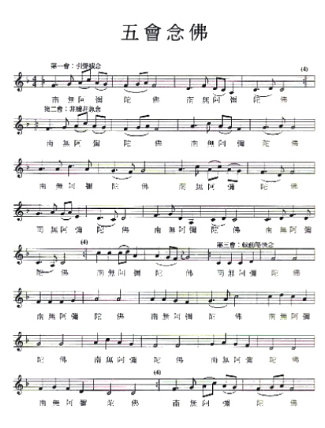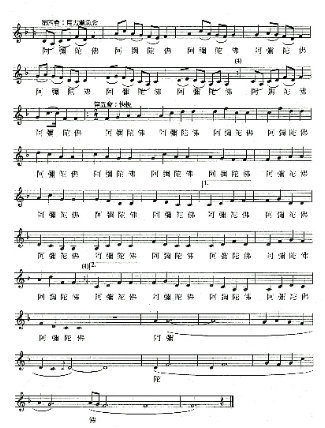Functions of the Tape of
Five-variation Chanting of Amitabha
Under the guidance of Dr. Yutang Lin
Written by Chun-Jane Chen
Edited by Ann Klein
I. The Origination of the "Five-Variation Chanting of Amitabha"
The Reverend Fa-Zhao, the fourth Patriarch of the Chinese Pureland School, entered the Pureland through his meditation; he heard Buddhas and Bodhisattvas, water, birds and trees, all singing the Five-variation Chanting of Amitabha. Amitabha Buddha told him that any sentient beings who encounter this Dharma treasure will want to chant the Buddha’s name. By doing so, they will surely cross the ocean of suffering and reach the shore of no regression in just one lifetime. Then Buddha entrusted him to propagate this method extensively.
However, the music score as dictated by the Reverend Fa-Zhao had been lost for ages. Fortunately, in the 1930’s, the Reverend Guan-Ben researched this matter and found two brief descriptions of that music score in the Japanese Tripitakas. Based on such descriptions, the Reverend Guan-Ben composed his own version, and disseminated that melodious chanting in order to bring about the ultimate salvation of all sentient beings.
In recent years, the Reverend Fa-Zhen rearranged this score, and with the accompaniment of the piano, the chorus of the Yuan-Guang Buddhist Institute taped it for circulation. However, it is designed for the morning and evening services, therefore, it contains praises at the beginning and dedication of merits at the end of the tape.
II. Special Characteristics of this Tape
Dr. Lin designed this tape for the daily practice of continuously chanting "Amitabha," and to assist dying persons to maintain the chanting during their final hours. He adopted the Reverend Fa-Zhen’s tape, but omitted the praises and the dedication of merits. He recorded only the chanting of Amitabha, repeatedly, on a 90-minute cassette. Dr. Lin felt that the 60-minute cassette needed to be reversed too frequently, and the 120-minute cassette was too thin and could break easily.
III. How to Utilize this Tape
Listen to it anytime, anywhere, and sing with it to keep a constant flow of "Amitabha" in your mind. Through singing the Buddha’s name, it is easier to release one’s feelings into it; and it will also help one achieve single-mindedness naturally.
By playing this tape at home frequently, the atmosphere will become harmonious and peaceful, and the Buddha’s name will be implanted deeply into the hearts of the family. It is especially helpful in teaching children to chant, because when they are used to hearing it, they will sing it spontaneously. This tape could also be played as a lullaby.
For the group-practice of chanting "Amitabha," this tape can be played as an accompaniment. When people get tired from chanting, they could just listen to it attentively.
During an illness, one can listen to this tape to feel calm and peaceful; the karmic obstacles will gradually be removed, and one’s health will be restored sooner.
During a dying person’s final hours, it is not easy for friends to gather to help with chanting, therefore, this tape can be played continuously to help maintain one’s peace.
I sincerely wish that people would duplicate and circulate this tape and article freely, so that more sentient beings will be able to share the benefits and eventually gain rebirth in Amitabha’s Pureland.
December 1, 1990


[Home][Back to list][Back to Chinese versions] MP3 A B C D E F